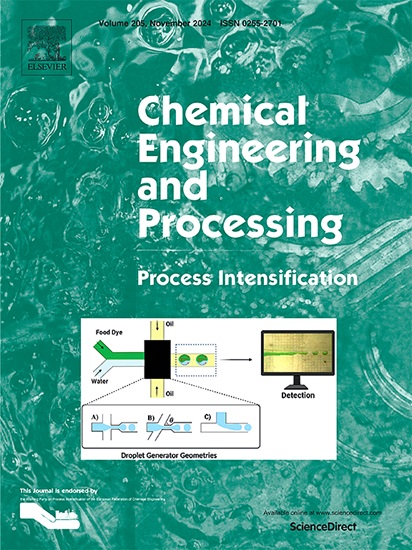Axial dispersion modelling of the residence time distribution in a millistructured plate reactor
IF 3.8
3区 工程技术
Q3 ENERGY & FUELS
Chemical Engineering and Processing - Process Intensification
Pub Date : 2025-03-28
DOI:10.1016/j.cep.2025.110295
引用次数: 0
Abstract
Micro- and millistructured reactors offer significant advantages compared to conventional batch reactors in terms of heat and mass transfer as well as process safety. Especially in case of fast and exothermic reactions, the space-time-yield of batch reactors is often limited by poor heat transfer and slow mixing. The use of millistructured reactors, such as the ART plate reactor PR37 of Ehrfeld Mikrotechnik, can overcome heat and mass transfer limitations and significantly extend applicable process windows, while providing sufficient capacity for industrial applications. Previous investigations showed that the reactor offers high heat transfer coefficients as well as short micromixing times at moderates Reynolds numbers. In order to further characterize the performance of the reactor and the possible operating window, the current work provides a thorough study of the residence time distribution on the basis of pulse experiments and a model-based evaluation of the deviation from ideal plug flow on the basis of the axial dispersion model. The results demonstrate that the reactor closely resembles the ideal plug flow even for Reynolds numbers of just about Re 100. Due to its meandering, periodically diverging/converging process channels, the formation of secondary flow is promoted resulting in an increased cross-mixing and thus a considerably reduced axial dispersion compared straight channels. For further analysis, as well as model-based assessment and design of the reactor, a correlation for the axial dispersion coefficient is derived which is applicable for a wide process window.

微结构板反应器停留时间分布的轴向分散模拟
与传统间歇式反应器相比,微结构和微结构反应器在传热传质和过程安全性方面具有显著的优势。特别是在快速和放热反应的情况下,间歇反应器的时空产率往往受到传热不良和混合缓慢的限制。使用微结构反应器,如Ehrfeld microtechnik的ART板式反应器PR37,可以克服传热传质限制,并显着延长适用的工艺窗口,同时为工业应用提供足够的容量。先前的研究表明,反应器在中等雷诺数下具有较高的传热系数和较短的微混合时间。为了进一步表征反应器的性能和可能的操作窗口,目前的工作在脉冲实验的基础上对停留时间分布进行了深入的研究,并在轴向弥散模型的基础上对理想塞流的偏差进行了基于模型的评估。结果表明,即使雷诺数仅为Re≈100,反应器也接近于理想的塞流。由于其弯曲的、周期性发散/收敛的过程通道,促进了二次流的形成,从而增加了交叉混合,从而大大降低了轴向弥散。为了进一步分析,以及基于模型的反应器评估和设计,导出了适用于宽工艺窗口的轴向弥散系数的相关性。
本文章由计算机程序翻译,如有差异,请以英文原文为准。
求助全文
约1分钟内获得全文
求助全文
来源期刊
CiteScore
7.80
自引率
9.30%
发文量
408
审稿时长
49 days
期刊介绍:
Chemical Engineering and Processing: Process Intensification is intended for practicing researchers in industry and academia, working in the field of Process Engineering and related to the subject of Process Intensification.Articles published in the Journal demonstrate how novel discoveries, developments and theories in the field of Process Engineering and in particular Process Intensification may be used for analysis and design of innovative equipment and processing methods with substantially improved sustainability, efficiency and environmental performance.

 求助内容:
求助内容: 应助结果提醒方式:
应助结果提醒方式:


